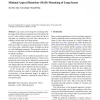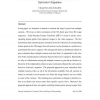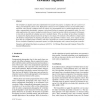86
Voted
IJCV
2008
15 years 24 days ago
2008
Abstract Long scenes can be imaged by mosaicing multiple images from cameras scanning the scene. We address the case of a video camera scanning a scene while moving in a long path,...
97
Voted
CVIU
2006
15 years 25 days ago
2006
We introduce a generic structure-from-motion approach based on a previously introduced, highly general imaging model, where cameras are modeled as possibly unconstrained sets of p...
108
click to vote
CVIU
2006
15 years 25 days ago
2006
In many multi-camera vision systems the effect of camera locations on the task-specific quality of service is ignored. Researchers in Computational Geometry have proposed elegant ...
97
Voted
COMPUTER
2006
15 years 25 days ago
2006
more abstract realms of Impressionism, and more pure Abstraction. The camera, although capable of capturing instants in time, cannot on its own--except in rare instances--truly rec...
148
click to vote
CVIU
2008
15 years 26 days ago
2008
The mainstream approach to estimate epipolar geometry from two views requires matching the projections of at least 4 non-coplanar points in the scene, assuming a full projective c...
119
click to vote
CVIU
2010
15 years 26 days ago
2010
In this paper, we introduce a method to estimate the object's pose from multiple cameras. We focus on direct estimation of the 3D object pose from 2D image sequences. Scale-I...
119
Voted
CGF
2008
15 years 27 days ago
2008
In this paper we present a new practical camera characterization technique to improve color accuracy in high dynamic range (HDR) imaging. Camera characterization refers to the pro...
106
click to vote
CGF
2008
15 years 27 days ago
2008
The viewfinder of a digital camera has traditionally been used for one purpose: to display to the user a preview of what is seen through the camera's lens. High quality camer...
131
Voted
CGF
2010
15 years 27 days ago
2010
Recent work have shown that it is possible to register multiple projectors on non-planar surfaces using a single uncalibrated camera instead of a calibrated stereo pair when deali...
113
Voted
AR
2010
2010
Development of a Visual Odometry System for a Wheeled Robot on Loose Soil using a Telecentric Camera
15 years 28 days ago
In this paper, the development of a three-dimensional (3-D) odometry system for wheeled robots on loose soil in an application of planetary exploration is described. When a wheele...




